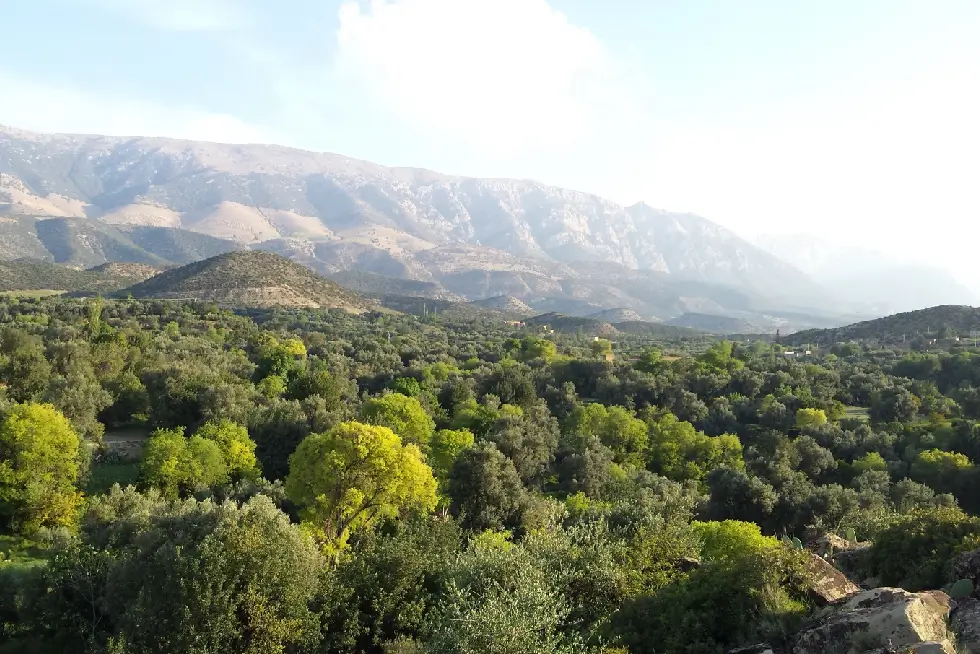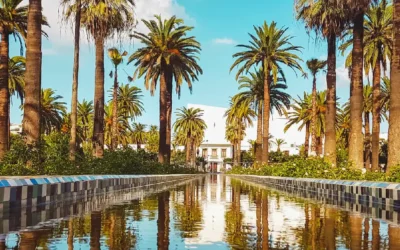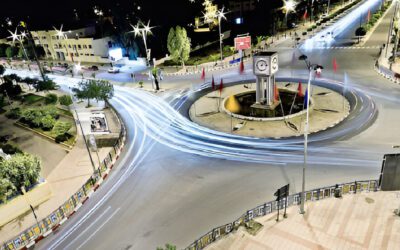Boulemane: A Town Of Morocco Amidst the Cedar Forests of the Atlas Mountains

Table of Contents:
Introduction To Boulemane Town
Boulemane is a town located in north-central Morocco in the Fès–Meknès region, nestled in the Middle Atlas mountains. Elevated approximately 5,500 feet (1,700 meters) above sea level.
The town is a hub for the Amazigh (Berber) semi-nomadic communities. Serving as a critical market center, it connects the cultural richness of the region with the outside world.
Boulemane is most known for its unique geographical and cultural characteristics. It’s a mountainous area, this region is particularly famous for its Cedar Forests, which are among the largest in Morocco.
These forests are not only a natural treasure but also home to a variety of wildlife, including the Barbary macaque, a species of monkey that is native to North Africa.
Boulemane Discovery Tour
Boulemane, a lesser-known yet captivating destination in Morocco, offers a range of attractions for visitors. While it may not be as widely recognized as other Moroccan cities, its unique offerings are sure to leave a lasting impression. Here are some of the top places to visit and discover:
1. Paradise Valley
Originally known as Tifrit Valley, this breathtaking location was renamed in the 70s by hippies. It’s a natural paradise that’s a must-see for its stunning landscapes.
2. Karaouiyine Mosque
A significant historical and religious landmark, commissioned by Al Fatima Al Banini Fihriya, this mosque is a pillar of the region’s history.
3. Aben Danan Synagogue
This 17th-century synagogue, revitalized in 1999, stands as a symbol of the area’s rich cultural diversity.
4. Médersa El-Attarine
Nestled just north of Fez’s old city, this 14th-century monument is an architectural marvel, reflecting the area’s historical depth.
5. Bulevar Hassan II
In the heart of Fez, this boulevard is a modern showcase of urban development and a window into contemporary life in the region.
6. Bab Makina
Famous for hosting an international sacred music festival, Bab Makina is a cultural hotspot, buzzing with musical events.
7. The Dyers Square
Located in a lively area north of Fez, this colorful square offers a peek into the local artisan world.
8. Souk de Boumalne
This bustling market is the go-to place for an authentic Moroccan shopping experience, offering a variety of local goods.
9. Nature Reserves and Valleys
Surrounding Boulemane, areas like Haute vallée du Dadès and Valle del Dades are havens for nature enthusiasts, brimming with natural beauty.
Boulemane Accessibility And Transportation
Boulemane is a gateway to an enchanting experience, though it’s not directly connected to major cities. However, it’s well-liked by various transport modes to prominent destinations like Casablanca and Rabat.
1. By Train
Speedy and Comfortable Moroccan Railways (ONCF) offers convenient train services. A notable route is from Ain Taoujdate to Casablanca, taking about 3 hours and 41 minutes, with trains departing every four hours.
Another key route is from Fès to Rabat, with a travel time of approximately 2 hours and 55 minutes. These train journeys promise both comfort and speed, available in both 1st and 2nd class.
2. By Bus
Versatile and Frequent For bus travelers, CTM buses run from Azrou to Casablanca and from Fes to Rabat.
The Fes-Rabat route, taking around 2 hours and 10 minutes, operates every 3 hours. CTM’s bus services cater to different preferences, offering Premium and Confort classes.
3. Personalized Travel
Luxury and Flexibility For those seeking a more tailored travel experience, the region provides options like chauffeured mini-bus rentals and coach hires.
These services are perfect for day trips, tours, or group transfers, offering both flexibility and privacy. They’re especially recommended for exploring the picturesque countryside of Fes-Boulemane.
4. Discover Fes-Boulemane
A Visual Feast Fes-Boulemane’s landscape, reminiscent of southern Italy’s lushness, is a visitor’s delight. The province is home to Fes, the world’s largest walled city, known for its narrow roads and vibrant medinas.
Road travel in the region is a treat, with its rolling hills and quaint villages. To fully enjoy the region’s attractions, including traditional villages and historic sites like the Roman ruins at Volubilis, private transport is advisable.
Modern Boulemane and its Economic Significance
Boulemane stands as a beacon of economic evolution. The town has witnessed a remarkable surge in population over recent decades. This isn’t just a number game; it reflects a vibrant, ever-evolving economic landscape.
Boulemane’s population growth isn’t in isolation – it’s a mirror to the larger demographic shifts across Morocco, where economic development and urbanization go hand in hand.
A. Infrastructure: The Backbone of Economic Development
Here’s where it gets interesting. Infrastructure development in Boulemane and similar regions is more than just building roads and railways; it’s about fueling economic growth.
Take, for example, the Kano-Kaduna railway project in Nigeria. This isn’t just about laying tracks; it’s about laying the groundwork for economic prosperity.
Such infrastructure projects are pivotal in enhancing mobility, boosting transportation efficiency, and energizing economic activities by linking crucial urban centers.
Though the Kano-Kaduna project is specific to Nigeria, its essence holds for Boulemane. By improving market access, cutting down transportation costs, and bringing regions closer, these projects significantly uplift the local economy.
B. Boulemane in the Modern Era: Geographical and Economic Symbiosis
Boulemane’s current economic significance is deeply rooted in its strategic geographical positioning, the demographic shift, and the undeniable benefits of enhanced infrastructure.
It stands as a testament to the transformative power of growth and development, akin to other burgeoning urban centers in the region.
Overview of Boulemane History
Boulemane’s history is deeply connected to Morocco’s overall historical tapestry. Its prominence comes from being a vital market hub for the Amazigh (Berber) semi-nomads. This key role underscores Boulemane’s impact on both local trade and cultural dynamics.
A. Influential Eras in Moroccan History
The broader region, including Fès-Boulemane, has witnessed pivotal moments shaping Morocco’s history. Notably, around 788 AD, Moorish dynasties, followed a century after the Arab conquest of North Africa.
The 16th century marked the ascent of the Sa’adi monarchy. Ahmad AL-MANSUR’s reign (1578-1603) stood out for repelling external threats and heralding a golden age.
B. Colonial Challenges and Independence
Morocco’s historical narrative also encompasses periods of external domination and colonization. In 1860, Spain’s occupation of northern Morocco ignited trade competition among European powers, gradually undermining Moroccan sovereignty.
This led to the establishment of a French protectorate in 1912. However, Morocco’s prolonged but ultimately victorious struggle for independence culminated in 1956.
C. Boulemane’s Strategic Significance
Boulemane has been significantly shaped by these historical events. Its strategic position in the Middle Atlas Mountains established it as a crucial point for local tribes and a link connecting various Moroccan regions.
Conclusion
Boulemane is a region where the splendor of nature meets rich cultural traditions. The warmth of its people, the beauty of the Middle Atlas Mountains, and the preservation of its cultural heritage make Boulemane a unique and unforgettable destination.
As both a historical treasure and a beacon of progress, Boulemane continues to captivate and inspire all who visit.
FAQ
What is Boulemane known for?
Boulemane is renowned for its Cedar Forests, one of the largest in Morocco, and its rich cultural heritage, especially its connection with the Amazigh (Berber) semi-nomadic communities.
What wildlife can be found in Boulemane?
The Cedar Forests around Boulemane are home to diverse wildlife, including the Barbary macaque, a species of monkey native to North Africa.
Where is Boulemane located?
Boulemane is situated in the Fès-Meknès region of north-central Morocco, nestled in the Middle Atlas mountains at an elevation of approximately 5,500 feet (1,700 meters).
What are some must-visit places in Boulemane?
Key attractions include Paradise Valley, Karaouiyine Mosque, Aben Danan Synagogue, Médersa El-Attarine, Bulevar Hassan II, Bab Makina, The Dyers Square, Souk de Boumalne, and nearby nature reserves and valleys.
How can I reach Boulemane?
Boulemane is accessible by train, with routes from Ain Taoujdate to Casablanca and Fès to Rabat. There are also CTM bus services from Azrou to Casablanca and Fes to Rabat. Personalized travel options like chauffeured mini-bus rentals are also available.
What makes Boulemane economically significant?
Boulemane has experienced substantial population growth and urbanization, reflecting its evolving economic landscape. Infrastructure developments have played a key role in boosting its economic growth.
What historical events have shaped Boulemane?
Boulemane’s history is intertwined with Morocco’s, influenced by Moorish dynasties, the Sa’adi monarchy, periods of European colonization, and its strategic position in the Middle Atlas Mountains.
Is Boulemane a good destination for nature enthusiasts?
Absolutely. The region’s Cedar Forests and surrounding nature reserves offer a splendid experience for nature lovers.
What cultural experiences does Boulemane offer?
Boulemane provides a deep dive into Moroccan culture, from its historical mosques and synagogues to vibrant markets and music festivals.
Can I find accommodation easily in Boulemane?
Yes, Boulemane offers a range of accommodations, from traditional guesthouses to modern hotels, catering to different preferences and budgets.



